“Power To The People” To Nominate Local Landmarks
Views: 640
Forest Hills & Rego Park Face A Landmarking Deficit
By Michael Perlman | mperlman@queensledger.com
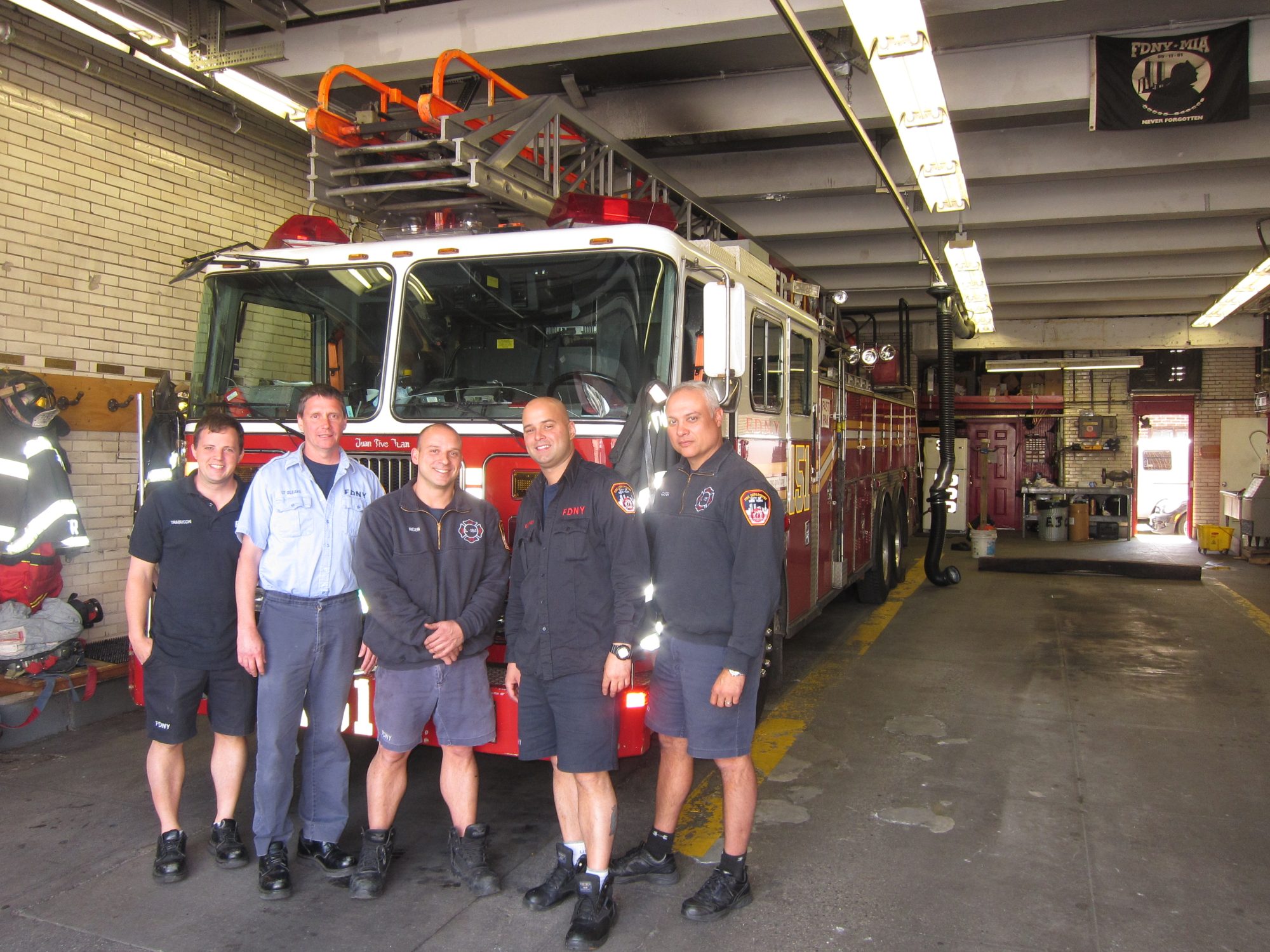
FDNY’s Bravest of Forest Hills, April 2012 photo by Michael Perlman
With Valentine’s Day around the corner, it is timely for residents among preservationists at large to express their love for not only one another, but in the form of civic pride by nominating cherished historic and distinctive buildings to establish landmark designations. Love should be in the air year-round.
Neighborhoods lose their beauty, originality, and architectural, historical, and cultural significance, and ultimately their identity as properties of interest are largely modified or demolished. Therefore, the public bears the power by law to drum up major support, so the NYC Landmarks Preservation Commission (LPC) can designate such properties and districts for current and future generations to appreciate individually and collectively.
Preservation-worthy sites may include theaters, places of worship, residential buildings and houses, commercial properties, and a tree or a sculpture. Distinctive local styles include Tudor, Gothic, Neo-Renaissance, Colonial, Georgian Colonial, Art Deco/Moderne, International style, and Mid-Century Modern, which enhance the quality of life for citywide residents and tourists.
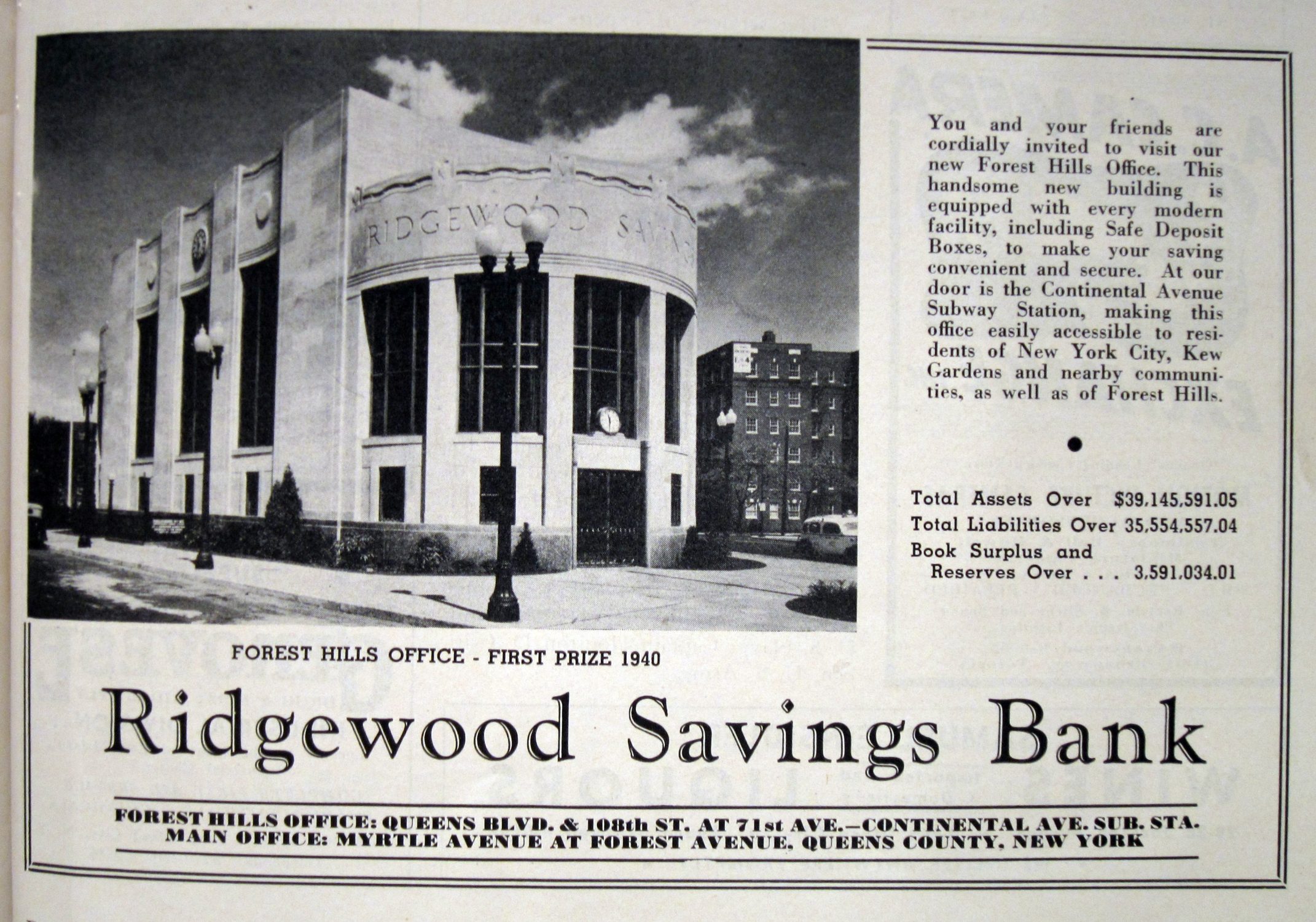
Ridgewood Savings Bank, 1942 ad, Courtesy of Queens Chamber of Commerce
In 1963, mass protests were underway to denounce the planned demolition of Manhattan’s classic Pennsylvania Station, a Beaux Arts gem by McKim, Mead & White, completed in 1911, but pleas fell upon deaf ears. Shortly after, a masterpiece was fed to the landfill, and then on April 19, 1965, the Landmarks Law became a reality, after Mayor Robert F. Wagner, signed the bill into a law. This was a model of a citizen-driven government, where residents hoped this unique achievement would prevent future travesties, whether small or large.
Rego-Forest Preservation Council, founded in 2006 by this columnist, advocates for landmark status in Rego Park, Forest Hills, and nearby communities, and documents local history. The public can play a role in the establishment of official landmarks by researching, photographing, and nominating properties of their choice by downloading and completing a Request For Evaluation form (RFE) on the LPC website. It can be mailed to the LPC at 1 Centre Street, 9th Floor North, New York, NY 10007 or via email at RFE@lpc.nyc.gov.
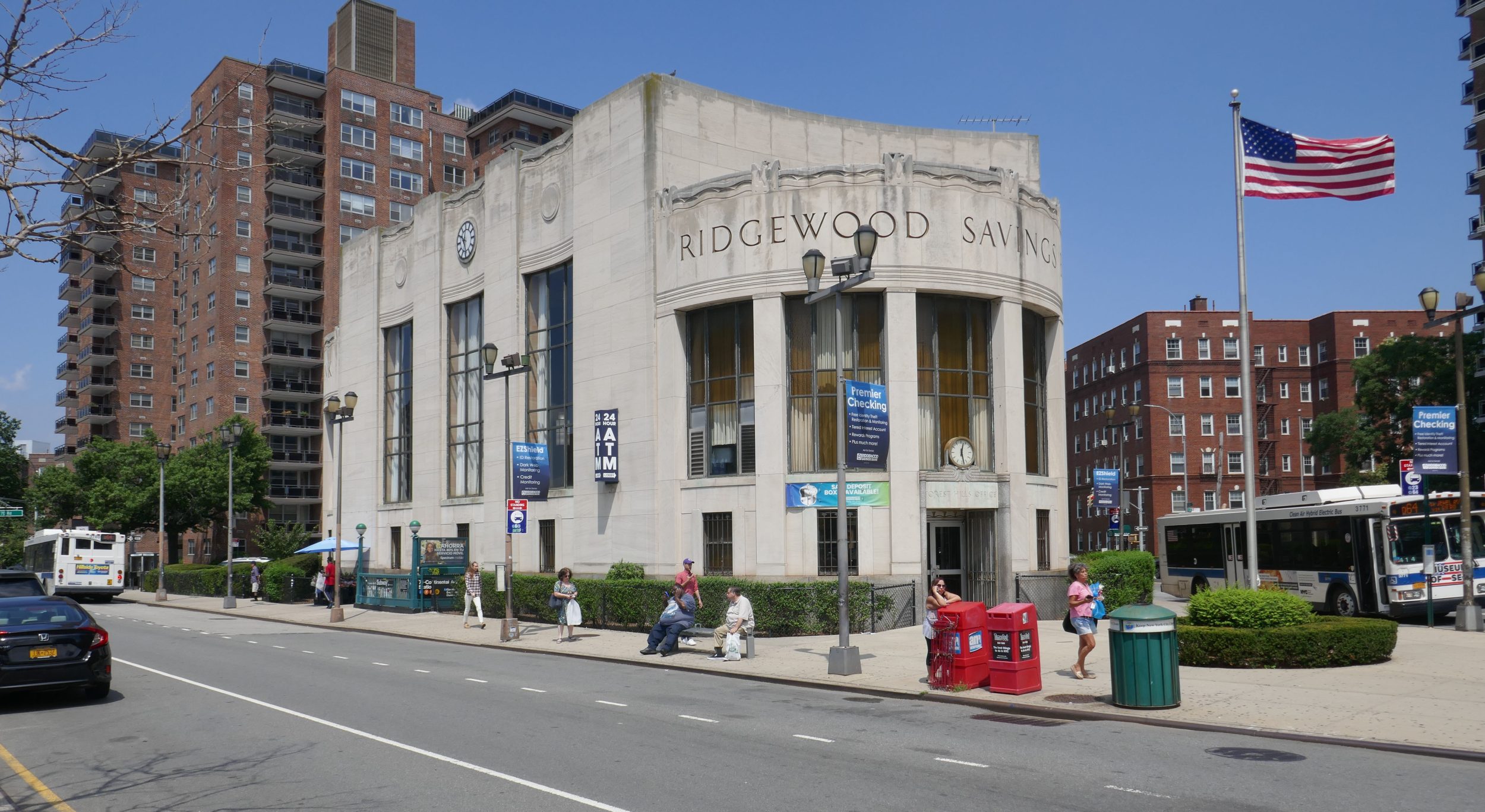
The landmarked Ridgewood Savings Bank, Photo by Michael Perlman, August 2019
Individual Landmarks (facades), Interior Landmarks, and Scenic Landmarks can be proposed by downloading an RFE through https://www.nyc.gov/assets/lpc/downloads/pdf/forms/RFE_form_20160720.pdf
Historic Districts can be proposed by including research for properties within selected boundary lines on a map by completing another variation of an RFE: https://www.nyc.gov/assets/lpc/downloads/pdf/forms/RFE_form_HD_20160720.pdf
Rego Park, which is often overlooked by the city, was appointed by the Historic Districts Council as a “Six To Celebrate” community in 2020 based on its architecture and history. Among the advocacy goals is to achieve landmark designations and publish a booklet featuring historic and landmark-worthy buildings; the latter goal which has been fulfilled. Forest Hills including Forest Close was a “Six To Celebrate” community in 2014, and also has a booklet available.
Current Forest Hills Individual Landmark designations are Remsen Cemetery (designated 1981), Ridgewood Savings Bank (designated 2000), and Engine 305 & Ladder 151 (designated 2012), but Rego Park has no official landmarks or Historic Districts yet. Outside of Forest Hills Gardens, buildings on the State & National Register of Historic Places include Rego Park Jewish Center and the Forest Hills Post Office, an official program under the State Historic Preservation Office which commemorates properties and also increases the likelihood of obtaining funds for historically-sensitive upgrades and restoration. However, only NYC landmark status can currently prevent demolition.
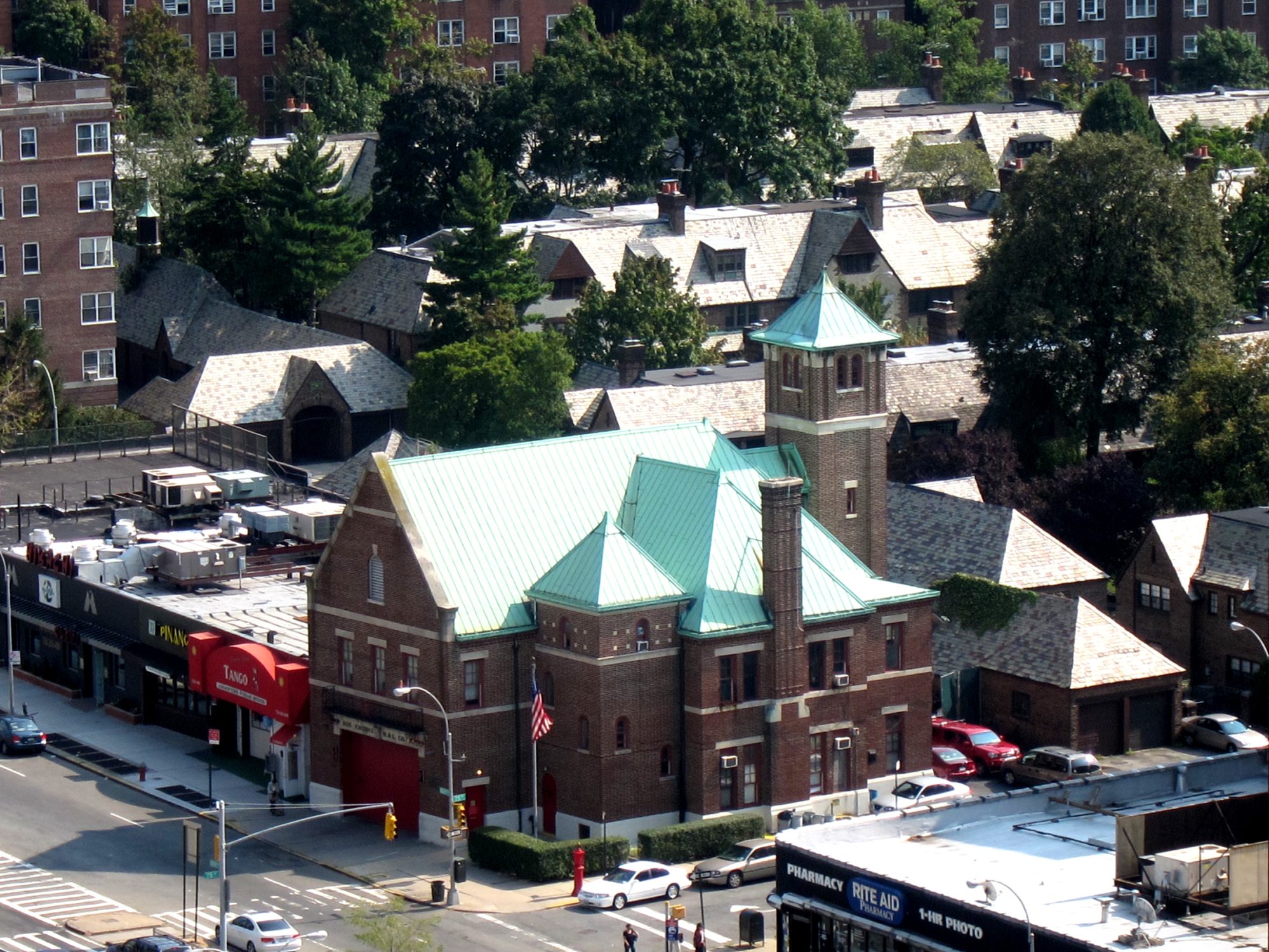
Engine Co 305, Hook & Ladder Co 151, Photo by Michael Perlman, September 2010
Despite Forest Hills originating in 1906 and Rego Park’s founding in 1923, and both communities having mostly intact historic buildings, they fall far behind in city landmark designations in comparison to other citywide communities, especially in Manhattan. In 2008, Rego-Forest Preservation Council filed a Freedom of Information Law (FOIL) request to access the LPC’s archives. It was determined that an overwhelming majority of public landmarking nominations for Individual Landmarks either remained stagnant in their files for a 20-year period, or were rejected with form letter excuses such as “altered beyond recognition” or “doesn’t meet the criteria for designation.” Many of those buildings have minimal alterations, but are most often designated in a greater altered state in Manhattan. It was also determined that the LPC employed its staff and invested its resources to publish a comprehensive survey of potential landmarks and districts titled “CB 6 January 1990 Survey,” but as the decades passed, the hundreds of pages were ignored and properties at large were not calendared for a public hearing, and ultimately not designated.
As time has proven, a property that is ignored or rejected by an LPC Director of Research and staff members during one mayoral administration has been reconsidered for landmarking when re-nominated by the public after the faces behind the Commission changed. Examples include Jamaica High School and the Jamaica branch of Jamaica Savings Bank.
Fast forwarding to 2025, one may question why the Landmarks Law, which would ideally spare historic buildings proactively from the wrecking ball through obtaining landmark designations, is performing on the contrary. The law falls short when the faces behind the LPC do not apply it equally or largely between boroughs, building types, and styles, and on the basis of somewhat altered versus intact conditions. Forest Hills and Rego Park are losing landmark-worthy sites due to demolition and major alterations more often than one may think. On a larger scale, it can be attributed to the lack of local properties that are calendared for public hearings and designated, as evident through the LPC’s public hearing records retrieved online.
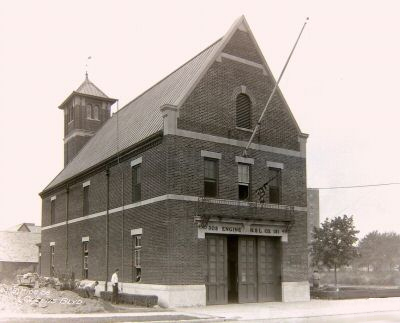
Engine Co 305, Hook & Ladder Co 151, 1920s
A case in point exists in Forest Hills’ Cord Meyer section, which represents lost potential landmarks. It was once the site of many more mostly intact Tudor and Colonial residences from the early 20th century to 1940s, sometimes designed by a well-respected architect along with a notable builder. Some may have been home to an influential individual, granting additional merit for landmark designation. Due to the LPC’s lack of intervention, many properties were replaced with McMansions and concrete lawns, but some original examples are now in the hands of the public to nominate for landmarking and maintain a community initiative.
Another example of major losses despite public nominations and petitions include the 1939 World’s Fair-inspired Art Deco Trylon Theatre, the Federal style Tower Diner bank building, and Parkside Chapel, which was recognized by the American Institute of Architects. Another example is the demolition of several of Forest Hills’ first developed properties consisting of Cord Meyer’s Neo-Renaissance rowhouses on 72nd Avenue (Roman Avenue) between Austin Street and Queens Boulevard, which reflect the name change from Whitepot to Forest Hills in 1906. Locally, some buildings earned 1st prize bronze plaques for their architectural and civic value by the Queens Chamber of Commerce, and have yet to be considered for landmarking.
The public attests that the LPC needs to establish a more transparent community-driven landmarking process with a clearer written criterion for designation on their website. This would coincide with the provisions of the Landmarks Law and their mission statement; both of which state that a landmark must be at least 30 years old, and exhibit architectural and/or cultural significance. Each community has its cornerstones, and the failure to designate in those communities represents an unequal representation.
The LPC is an agency consisting of a panel of 11 commissioners that are appointed by the mayor and supported by a staff of approximately 80 preservationists, researchers, architects, historians, attorneys, archaeologists, and administrative employees, according to their website. New York City’s five boroughs offer greater than 38,000 landmarked properties, where the majority are situated within 157 historic districts and historic district extensions. The total quantity of properties also consists of 1,464 individual landmarks, 123 interior landmarks, and 12 scenic landmarks.
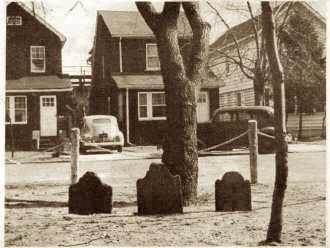
Remsen Cemetery in 1950, Courtesy of Historian Ron Marzlock
The Chair is Sarah Carroll and the Vice Chair is Frederick Bland. The new Director of Research is Margaret Herman, an architectural historian who previously served as Deputy Director of Research. Her responsibilities include thematic surveys, overseeing the landmark designation process, and special projects. She also meets with community groups, property owners, and elected officials to discuss potential landmark designations.
The landmarked Ridgewood Savings Bank at 107-55 Queens Boulevard was erected from 1939 to 1940, after the bank chose to expand from its native home in Ridgewood which originated in 1921. Representatives envisioned taking advantage of the growing Forest Hills community, which was influenced by the development of the IND subway line in 1936 and the 1939 World’s Fair. The notable New York-based firm, Halsey, McCormack & Helmer, which specialized in bank architecture, presented residents with a 3-story high Modern Classical bank, creatively configured on a landscaped triangular plot. Doors opened on April 6, 1940, and later that year, the bank was a recipient of a first prize award by the Queens Chamber of Commerce for its “excellence of design and civic value.”
Distinctive features of the convex and concave smooth Alabama Rockwood stone and polished Deer Island granite façade include flat eagles aligned with pilasters, large bronze-tinted windows, streamlined and wave-like incised designs, Modernist clocks, and grilles. The mostly intact interior features a streamlined ceiling designed by Angelo Magnanti with Art Deco fixtures, travertine floors, buff pink Mansota stone walls on a wainscot of polished Rosato D’Or marble which is carried onto the counters, and wrought iron and bronze teller screens, check desks, and railings.
Forest Hills’ earliest extant commemorative site, Remsen Family Cemetery, was designated after a heroic initiative by residents. Situated on a park-like setting between Trotting Course Lane and Alderton Street, the cemetery contains tombstones dating from 1790 through 1819. Flanking a flagpole, two doughboys honor Forest Hills’ service in WWI.
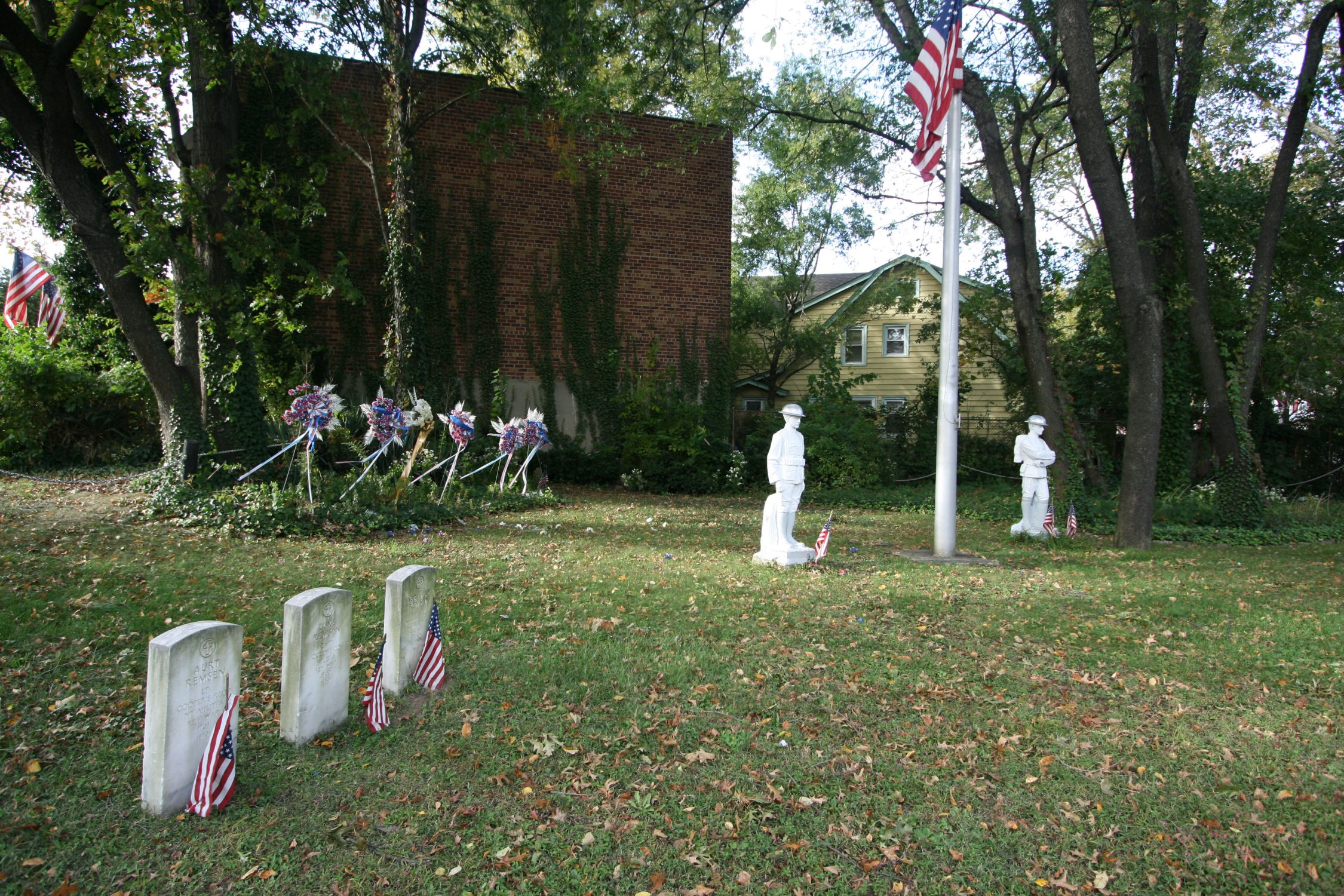
Later addition of limestone tombstones at Remsen Cemetery with doughboys, Photo by Michael Perlman
In Colonial times, it was popular for families to have private cemeteries close to home. The Remsen family erected a homestead on their farm adjacent to the cemetery in 1699, which stood until 1925. Jeromus Remsen Sr. (1735 – 1790) fought in the French and Indian War. As colonel of the Kings and Queens County Militia in the Battle of Long Island, he commanded the 7th New York Regiment in the American Revolutionary War.
The Remsen Park Coalition’s 1981 plaque states, “Within this park lies the remains of Revolutionary War Veteran Colonel Jeromus Remsen. Buried in the confines of this site were his cousins Major Abraham Remsen, Captain Luke Remsen, Lieutenant Aurt Remsen and their families. The Remsen family was amongst the first settlers of this area, originally known as White Pot.” A 1925 survey revealed brownstone grave inscriptions of Jeromus, Anna, Jerome (two), Cornelius, Ann Elizabeth, Bridget, and Major Abraham Remsen. The Veterans Administration erected non-brownstone graves that memorialize Colonel Remsen, Maj. Abraham Remsen, and brothers Aurt and Garrett Remsen, who were also Revolutionary War officers. Some brownstone tombstones have vanished and remain a mystery.
The Neo-Medieval style Engine Company 305, Hook & Ladder Company 151 at 111-02 Queens Boulevard was erected to serve a growing population due to post-WWI Forest Hills residential construction. The firehouse’s design was fulfilled by John R. Sliney, the FDNY’s head building inspector. On the façade lies a bronze plaque dated 1923 and features notables including Forest Hills’-own Mayor John F. Hylan and Fire Commissioner Thomas J. Drennan. The façade features brick in a Flemish bond and decorative limestone details. Asymmetrical massing is accentuated by steep gables with copper standing-seam roofs, two square towers featuring round-arched windows, and a tall slender chimney.
At its November 1924 opening, FDNY chief Hubert J. Treacy of the Bureau of Repairs praised it as “the most pretentious fire engine house in the Greater City.” On dedication day, the Long Island Daily Star explained that it was “constructed to harmonize with the architecture of the surrounding community,” which included Forest Hills Gardens.
The firehouse’s more recent years also bear great significance. FDNY firefighter John DePierro held a record as the longest serving firefighter from 1969 to 2012. On September 11, 2001, Engine Co. 305 witnessed the casualties of senior firefighter Peter Nelson and firefighter Joe Hunter. Within its walls exists a superb example of camaraderie, which facilitates teamwork to extinguish fires.
A landmark is most ideally in the eyes of the majority, in addition to having architectural and/or cultural merit. In 2022, Lorna Nowvé, who served as the interim executive director of the Historic Districts Council, the city’s largest preservation advocate non-profit for NYC’s historic neighborhoods, explained, “The best way that people can advocate for the preservation of buildings is to be observant. Take in not only the beauty of their neighborhoods, but also if they see areas of concern regarding neglect of a building or a potential development threat. We always encourage people to read their local newspapers and social media sites that refer to their neighborhoods and other areas that they love. If you can, get involved with your local community board.” Residents can also join preservation groups including Rego-Forest Preservation Council, Four Borough Neighborhood Preservation Alliance, and Historic Districts Council.
To volunteer by nominating properties to earn landmark status, email mperlman@queensledger.com and join Rego-Forest Preservation Council on Facebook.
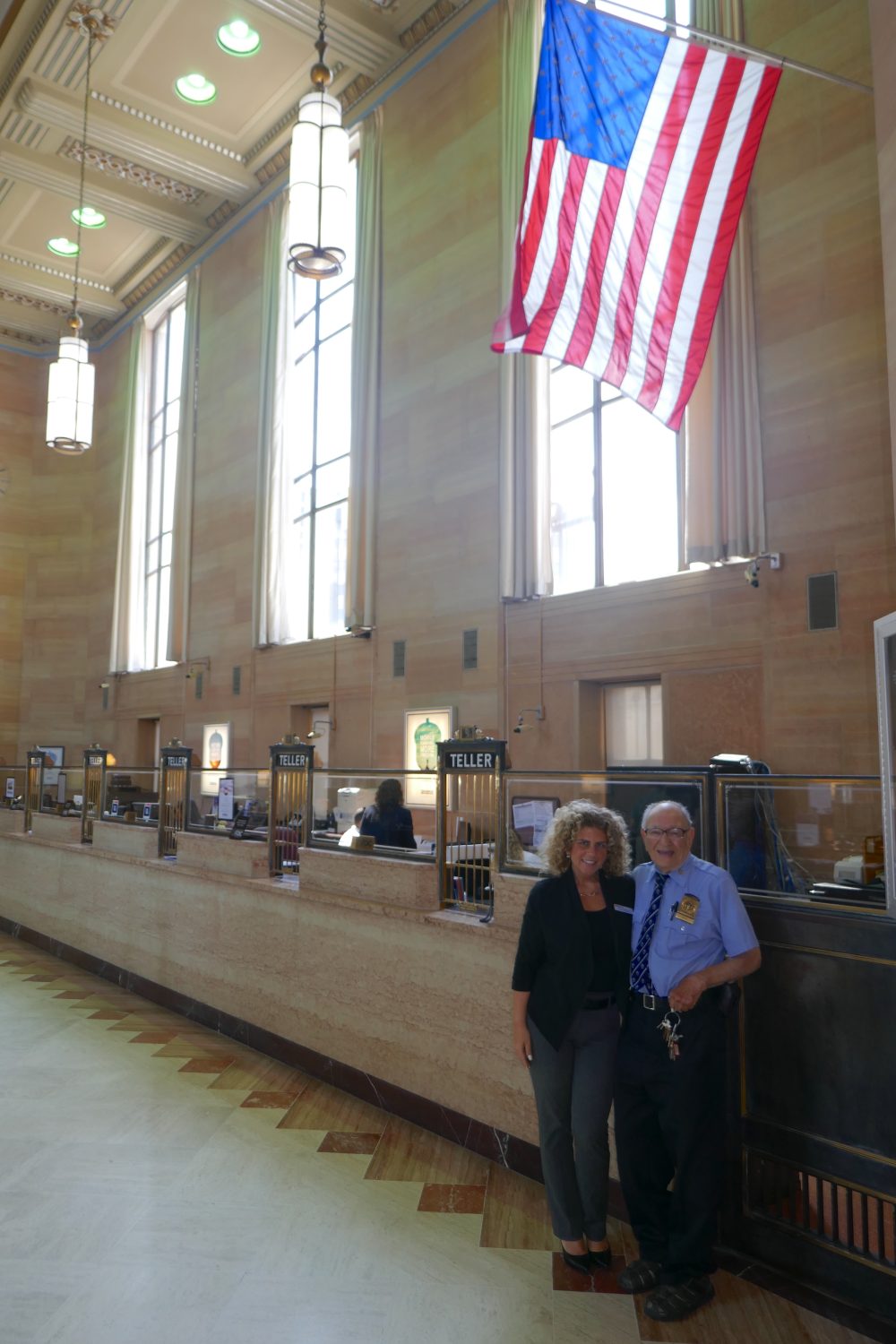
Ridgewood Savings Bank Branch manager Nancy Adzemovic with the late Richie, Photo by Michael Perlman, August 2019

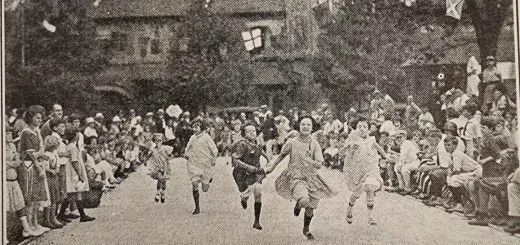
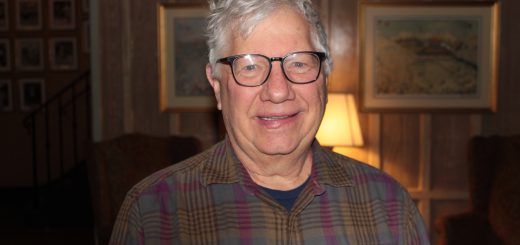
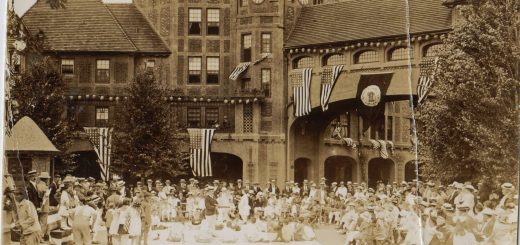
It’s not myy first tme too ppay a quhick visit this web page, i amm browsing
this websit dailly and gget fastidious facts ffrom here everyday.
rsp6j6
Wow, marvelous blog structure! How long have you been blogging for? you make blogging glance easy. The entire look of your site is excellent, let alone the content!
Thank you, I’ve recently been searching for info about this topic for a long time and yours is the best I’ve discovered till now. However, what about the bottom line? Are you positive concerning the supply?
Thanks , I have recently been looking for information about this topic for a long time and yours is the best I have discovered so far. However, what about the bottom line? Are you certain in regards to the supply?
you’re in point of fact a excellent webmaster. The website loading velocity is amazing. It sort of feels that you’re doing any unique trick. Moreover, The contents are masterwork. you have done a fantastic task on this matter!
olympe casino avis: olympe casino avis – olympe casino
Excellent web site. Lots of helpful information here. I?¦m sending it to some friends ans also sharing in delicious. And naturally, thank you for your effort!
kamagra en ligne: Kamagra Oral Jelly pas cher – Kamagra Oral Jelly pas cher
Pharmacie en ligne Cialis sans ordonnance: cialis sans ordonnance – Acheter Cialis 20 mg pas cher tadalmed.shop
acheter mГ©dicament en ligne sans ordonnance [url=http://pharmafst.com/#]Livraison rapide[/url] pharmacie en ligne france livraison belgique pharmafst.shop
pharmacie en ligne pas cher: pharmacie en ligne – acheter mГ©dicament en ligne sans ordonnance pharmafst.com
http://kamagraprix.com/# kamagra oral jelly
pharmacie en ligne france fiable [url=http://pharmafst.com/#]Pharmacie en ligne France[/url] pharmacie en ligne pas cher pharmafst.shop
achat kamagra: achat kamagra – kamagra gel
https://tadalmed.shop/# Acheter Viagra Cialis sans ordonnance
cialis prix: cialis prix – Acheter Cialis 20 mg pas cher tadalmed.shop
Pharmacie en ligne livraison Europe [url=http://pharmafst.com/#]Livraison rapide[/url] pharmacie en ligne sans ordonnance pharmafst.shop
http://tadalmed.com/# Tadalafil sans ordonnance en ligne
Acheter Viagra Cialis sans ordonnance: Cialis sans ordonnance pas cher – cialis generique tadalmed.shop
Cialis en ligne: Tadalafil 20 mg prix en pharmacie – Cialis generique prix tadalmed.shop
pharmacie en ligne france pas cher [url=https://pharmafst.com/#]pharmacie en ligne sans ordonnance[/url] pharmacie en ligne pas cher pharmafst.shop
https://tadalmed.shop/# Tadalafil 20 mg prix en pharmacie
pharmacie en ligne sans ordonnance: Pharmacie en ligne France – trouver un mГ©dicament en pharmacie pharmafst.com
kamagra oral jelly: kamagra en ligne – achat kamagra
https://tadalmed.shop/# Cialis generique prix
pharmacie en ligne france pas cher [url=https://pharmafst.com/#]Livraison rapide[/url] pharmacie en ligne pharmafst.shop
Achetez vos kamagra medicaments: Acheter Kamagra site fiable – kamagra en ligne
Acheter Viagra Cialis sans ordonnance: Cialis en ligne – Cialis sans ordonnance 24h tadalmed.shop
http://kamagraprix.com/# Achetez vos kamagra medicaments
Achat mГ©dicament en ligne fiable [url=https://pharmafst.com/#]pharmacie en ligne sans ordonnance[/url] pharmacie en ligne sans ordonnance pharmafst.shop
Pharmacie sans ordonnance: Meilleure pharmacie en ligne – pharmacie en ligne france pas cher pharmafst.com
pharmacie en ligne france livraison internationale: pharmacie en ligne – pharmacie en ligne sans ordonnance pharmafst.com
http://pharmafst.com/# Achat mГ©dicament en ligne fiable
achat kamagra: achat kamagra – kamagra 100mg prix
pharmacie en ligne france pas cher [url=https://pharmafst.com/#]pharmacie en ligne pas cher[/url] pharmacie en ligne pas cher pharmafst.shop
Cialis sans ordonnance 24h: Tadalafil 20 mg prix sans ordonnance – Cialis sans ordonnance 24h tadalmed.shop
п»їpharmacie en ligne france: Meilleure pharmacie en ligne – pharmacie en ligne sans ordonnance pharmafst.com
https://kamagraprix.com/# kamagra livraison 24h
Tadalafil achat en ligne: Cialis sans ordonnance 24h – Acheter Cialis 20 mg pas cher tadalmed.shop
Cialis sans ordonnance pas cher [url=https://tadalmed.com/#]Cialis sans ordonnance pas cher[/url] cialis sans ordonnance tadalmed.com
Pharmacie en ligne Cialis sans ordonnance: Cialis sans ordonnance 24h – Achat Cialis en ligne fiable tadalmed.shop
https://tadalmed.shop/# Pharmacie en ligne Cialis sans ordonnance
http://tadalmed.com/# Acheter Cialis 20 mg pas cher
https://tadalmed.com/# Achat Cialis en ligne fiable
kamagra 100mg prix [url=https://kamagraprix.shop/#]kamagra pas cher[/url] kamagra oral jelly
Cialis sans ordonnance 24h: Pharmacie en ligne Cialis sans ordonnance – Cialis generique prix tadalmed.shop
kamagra oral jelly: Achetez vos kamagra medicaments – Kamagra pharmacie en ligne
trouver un mГ©dicament en pharmacie [url=https://pharmafst.com/#]Medicaments en ligne livres en 24h[/url] pharmacie en ligne sans ordonnance pharmafst.shop
canadadrugpharmacy com: canadian pharmacy scam – cheap canadian pharmacy online
http://expressrxcanada.com/# canadian pharmacy antibiotics
indian pharmacy: indian pharmacy online – indian pharmacy online shopping
medicine courier from India to USA [url=https://medicinefromindia.com/#]online shopping pharmacy india[/url] top 10 online pharmacy in india
canadian pharmacy world: Canadian pharmacy shipping to USA – best canadian pharmacy online
https://medicinefromindia.shop/# MedicineFromIndia
MedicineFromIndia: indian pharmacy online – MedicineFromIndia
Rx Express Mexico [url=http://rxexpressmexico.com/#]mexico pharmacy order online[/url] Rx Express Mexico
indian pharmacy online shopping: indian pharmacies safe – medicine courier from India to USA
canadian online pharmacy: Canadian pharmacy shipping to USA – best rated canadian pharmacy
https://medicinefromindia.com/# Medicine From India
canadianpharmacyworld [url=https://expressrxcanada.shop/#]Express Rx Canada[/url] canadian pharmacy no scripts
canadian pharmacy online: Express Rx Canada – pharmacy rx world canada
mexico pharmacy order online: mexico pharmacy order online – mexican rx online
https://expressrxcanada.com/# canadian pharmacy tampa
mexico pharmacies prescription drugs: buying from online mexican pharmacy – mexican online pharmacy
mexican rx online [url=https://rxexpressmexico.com/#]mexico pharmacies prescription drugs[/url] mexico pharmacies prescription drugs
mexico drug stores pharmacies: Rx Express Mexico – mexican rx online
indian pharmacy: indian pharmacy online shopping – indian pharmacy online
http://rxexpressmexico.com/# mexican online pharmacy
indian pharmacy online: medicine courier from India to USA – MedicineFromIndia
canadian discount pharmacy: Canadian pharmacy shipping to USA – cheapest pharmacy canada
MedicineFromIndia [url=https://medicinefromindia.com/#]Medicine From India[/url] indian pharmacy online shopping
http://expressrxcanada.com/# real canadian pharmacy
mexico pharmacy order online: mexico drug stores pharmacies – mexico drug stores pharmacies
Medicine From India: indian pharmacy – MedicineFromIndia
http://medicinefromindia.com/# indian pharmacy online shopping
mexican rx online [url=https://rxexpressmexico.com/#]RxExpressMexico[/url] mexico drug stores pharmacies
mexico pharmacies prescription drugs: Rx Express Mexico – RxExpressMexico
canada drugstore pharmacy rx [url=http://expressrxcanada.com/#]Canadian pharmacy shipping to USA[/url] cross border pharmacy canada
вавада: vavada вход – вавада зеркало
https://pinuprus.pro/# пин ап казино
вавада казино [url=http://vavadavhod.tech/#]вавада казино[/url] vavada вход
пинап казино: пинап казино – пин ап вход
https://vavadavhod.tech/# вавада казино
вавада казино [url=https://vavadavhod.tech/#]vavada casino[/url] вавада
pin up: pin-up – pin up casino
https://pinupaz.top/# pin up
pin up [url=https://pinupaz.top/#]pin up az[/url] pin up azerbaycan
пинап казино: пинап казино – пин ап казино официальный сайт
http://pinupaz.top/# pin up azerbaycan
вавада зеркало [url=https://vavadavhod.tech/#]vavada[/url] vavada
pin up: pin up azerbaycan – pin up azerbaycan
https://pinupaz.top/# pin up azerbaycan
пин ап вход: pin up вход – пин ап зеркало
вавада зеркало: vavada вход – vavada
vavada casino: vavada вход – вавада казино
vavada: вавада – вавада
вавада: vavada – вавада казино
пин ап казино официальный сайт [url=http://pinuprus.pro/#]pin up вход[/url] пин ап зеркало
https://pinuprus.pro/# пин ап казино
вавада: vavada – vavada
pin up azerbaycan [url=http://pinupaz.top/#]pinup az[/url] pin up azerbaycan
вавада официальный сайт: vavada casino – вавада
вавада: вавада – vavada вход
пин ап зеркало: пин ап зеркало – пинап казино
https://vavadavhod.tech/# вавада
vavada вход: вавада казино – вавада официальный сайт
вавада [url=http://vavadavhod.tech/#]vavada вход[/url] вавада зеркало
pin-up: pin up az – pin up azerbaycan
http://pinupaz.top/# pin up
пинап казино: пин ап зеркало – пин ап зеркало
вавада зеркало [url=http://vavadavhod.tech/#]vavada вход[/url] vavada
пин ап зеркало: pin up вход – пин ап вход
http://vavadavhod.tech/# vavada
вавада зеркало: vavada вход – вавада
pin up az: pin up casino – pin-up
pin-up [url=http://pinupaz.top/#]pin-up[/url] pinup az
https://pinuprus.pro/# пин ап вход
pin up az: pin up azerbaycan – pin-up
вавада: вавада официальный сайт – вавада казино
https://pinupaz.top/# pin up casino
pinup az: pinup az – pin up casino
http://pinupaz.top/# pinup az
пин ап казино официальный сайт: пин ап вход – пин ап зеркало
http://vavadavhod.tech/# вавада казино
пин ап казино: пин ап казино – пин ап зеркало
пинап казино [url=https://pinuprus.pro/#]пин ап вход[/url] пин ап зеркало
pin up: pinup az – pin up az
пин ап казино: pin up вход – pin up вход
http://pinupaz.top/# pinup az
pin-up [url=http://pinupaz.top/#]pin up azerbaycan[/url] pinup az
пинап казино [url=http://pinuprus.pro/#]пин ап казино[/url] пин ап казино официальный сайт
https://pinuprus.pro/# пин ап вход
пин ап казино: пин ап казино – пин ап казино официальный сайт
vavada casino [url=http://vavadavhod.tech/#]vavada[/url] вавада зеркало
pin-up: pin up – pin up az
pin up azerbaycan [url=http://pinupaz.top/#]pin up[/url] pin up azerbaycan
pin up az: pin up – pin up
http://pinupaz.top/# pin up casino
вавада казино: вавада зеркало – вавада зеркало
пин ап вход [url=https://pinuprus.pro/#]пинап казино[/url] пинап казино
https://pinuprus.pro/# пин ап зеркало
vavada вход: vavada casino – вавада зеркало
вавада казино: vavada вход – vavada casino
вавада казино: вавада казино – vavada casino
пинап казино [url=https://pinuprus.pro/#]пинап казино[/url] пин ап вход
pin up casino: pinup az – pin up
http://vavadavhod.tech/# вавада зеркало
пинап казино [url=https://pinuprus.pro/#]пин ап казино[/url] пин ап казино официальный сайт
pin up az: pinup az – pin up casino
https://pinupaz.top/# pin up azerbaycan
вавада казино [url=http://vavadavhod.tech/#]вавада официальный сайт[/url] вавада официальный сайт
вавада казино: vavada вход – вавада
vavada casino: vavada вход – вавада официальный сайт
vavada вход: vavada – вавада зеркало
пин ап зеркало [url=http://pinuprus.pro/#]пин ап зеркало[/url] пинап казино
http://pinupaz.top/# pin up azerbaycan
пин ап казино [url=http://pinuprus.pro/#]пин ап казино официальный сайт[/url] пин ап зеркало
https://pinupaz.top/# pin up casino
pin up az: pin up casino – pin up az
http://vavadavhod.tech/# вавада казино
pin up az: pin up casino – pin-up casino giris
пин ап вход [url=http://pinuprus.pro/#]пин ап казино[/url] пин ап зеркало
http://pinuprus.pro/# пин ап казино официальный сайт
пинап казино: пин ап зеркало – пин ап вход
pin up az [url=http://pinupaz.top/#]pin-up[/url] pinup az
https://vavadavhod.tech/# vavada вход
pin up вход: пин ап казино официальный сайт – пин ап вход
http://vavadavhod.tech/# вавада
пин ап казино официальный сайт [url=http://pinuprus.pro/#]pin up вход[/url] пин ап зеркало
http://vavadavhod.tech/# вавада официальный сайт
пин ап казино официальный сайт: pin up вход – пин ап вход
http://pinuprus.pro/# пин ап зеркало
vavada [url=https://vavadavhod.tech/#]vavada[/url] vavada
pinup az: pin-up casino giris – pin-up
https://pinuprus.pro/# пин ап вход
pin-up [url=http://pinupaz.top/#]pin-up casino giris[/url] pinup az
пин ап вход: пин ап зеркало – пин ап вход
http://pinupaz.top/# pin up azerbaycan
trusted Viagra suppliers: generic sildenafil 100mg – cheap Viagra online
same-day Viagra shipping [url=http://maxviagramd.com/#]best price for Viagra[/url] secure checkout Viagra
http://maxviagramd.com/# buy generic Viagra online
Viagra without prescription: buy generic Viagra online – best price for Viagra
affordable ED medication [url=https://zipgenericmd.shop/#]secure checkout ED drugs[/url] online Cialis pharmacy
safe modafinil purchase: modafinil pharmacy – modafinil legality
https://modafinilmd.store/# legal Modafinil purchase
discreet shipping ED pills: FDA approved generic Cialis – discreet shipping ED pills
buy generic Viagra online: fast Viagra delivery – same-day Viagra shipping
Cialis without prescription [url=https://zipgenericmd.com/#]reliable online pharmacy Cialis[/url] generic tadalafil
Modafinil for sale: buy modafinil online – modafinil 2025
order Viagra discreetly: legit Viagra online – order Viagra discreetly
buy modafinil online: purchase Modafinil without prescription – verified Modafinil vendors
https://zipgenericmd.com/# online Cialis pharmacy
safe modafinil purchase: legal Modafinil purchase – safe modafinil purchase
buy generic Cialis online: online Cialis pharmacy – affordable ED medication
modafinil 2025 [url=http://modafinilmd.store/#]verified Modafinil vendors[/url] legal Modafinil purchase
online Cialis pharmacy: order Cialis online no prescription – secure checkout ED drugs
same-day Viagra shipping: secure checkout Viagra – safe online pharmacy
safe modafinil purchase: modafinil legality – modafinil 2025
legal Modafinil purchase [url=http://modafinilmd.store/#]legal Modafinil purchase[/url] safe modafinil purchase
online Cialis pharmacy: FDA approved generic Cialis – discreet shipping ED pills
https://modafinilmd.store/# verified Modafinil vendors
legit Viagra online: safe online pharmacy – legit Viagra online
online Cialis pharmacy: cheap Cialis online – cheap Cialis online
legal Modafinil purchase [url=https://modafinilmd.store/#]buy modafinil online[/url] modafinil legality
legit Viagra online: best price for Viagra – best price for Viagra
https://modafinilmd.store/# verified Modafinil vendors
reliable online pharmacy Cialis: secure checkout ED drugs – Cialis without prescription
legit Viagra online: legit Viagra online – secure checkout Viagra
safe modafinil purchase [url=http://modafinilmd.store/#]modafinil legality[/url] doctor-reviewed advice
legal Modafinil purchase: doctor-reviewed advice – modafinil pharmacy
generic tadalafil: online Cialis pharmacy – affordable ED medication
https://zipgenericmd.com/# order Cialis online no prescription
Cialis without prescription: affordable ED medication – best price Cialis tablets
Cialis without prescription: Cialis without prescription – best price Cialis tablets
trusted Viagra suppliers [url=https://maxviagramd.com/#]legit Viagra online[/url] trusted Viagra suppliers
modafinil pharmacy: verified Modafinil vendors – verified Modafinil vendors
cheap Cialis online: online Cialis pharmacy – best price Cialis tablets
Modafinil for sale: modafinil pharmacy – verified Modafinil vendors
affordable ED medication [url=https://zipgenericmd.com/#]online Cialis pharmacy[/url] cheap Cialis online
discreet shipping: no doctor visit required – buy generic Viagra online
best price Cialis tablets: generic tadalafil – online Cialis pharmacy
best price Cialis tablets: secure checkout ED drugs – Cialis without prescription
modafinil pharmacy [url=https://modafinilmd.store/#]legal Modafinil purchase[/url] modafinil 2025
https://zipgenericmd.shop/# secure checkout ED drugs
secure checkout Viagra: no doctor visit required – legit Viagra online
discreet shipping ED pills: order Cialis online no prescription – reliable online pharmacy Cialis
Viagra without prescription: order Viagra discreetly – trusted Viagra suppliers
http://zipgenericmd.com/# FDA approved generic Cialis
same-day Viagra shipping: legit Viagra online – Viagra without prescription
cheap Cialis online: cheap Cialis online – best price Cialis tablets
https://clomhealth.com/# cost generic clomid without dr prescription
prednisone for cheap: PredniHealth – prednisone cream rx
amoxicillin 500mg cost: amoxicillin where to get – Amo Health Care
PredniHealth: PredniHealth – PredniHealth
buying prednisone without prescription [url=https://prednihealth.com/#]PredniHealth[/url] PredniHealth
https://prednihealth.com/# PredniHealth
over the counter prednisone cheap: prednisone brand name us – PredniHealth
Amo Health Care: amoxicillin 30 capsules price – amoxicillin 500mg cost
PredniHealth [url=https://prednihealth.shop/#]prednisone pill[/url] PredniHealth
https://amohealthcare.store/# how to buy amoxicillin online
PredniHealth: PredniHealth – PredniHealth
PredniHealth: PredniHealth – PredniHealth
non prescription prednisone 20mg: PredniHealth – prednisone capsules
https://amohealthcare.store/# Amo Health Care
where to buy generic clomid pills [url=https://clomhealth.com/#]Clom Health[/url] order clomid no prescription
can i purchase clomid no prescription: Clom Health – where buy cheap clomid
where buy clomid without a prescription: can i get generic clomid price – where can i get generic clomid now
purchase prednisone 10mg: buy prednisone online india – prednisone 50
https://prednihealth.shop/# buy 10 mg prednisone
where can i buy clomid pills: how can i get clomid – where can i get clomid pill
clomid generic [url=https://clomhealth.shop/#]Clom Health[/url] can i order generic clomid without a prescription
amoxicillin from canada: amoxicillin online canada – where to buy amoxicillin 500mg
where can you buy prednisone: prednisone in canada – PredniHealth
https://clomhealth.shop/# can i buy clomid prices
can i get generic clomid without prescription [url=https://clomhealth.com/#]Clom Health[/url] cheap clomid without dr prescription
Amo Health Care: amoxicillin 500mg capsule buy online – amoxicillin 500mg buy online canada
can i buy generic clomid without rx: Clom Health – can i order cheap clomid without rx
https://prednihealth.com/# prednisone 50
amoxicillin 500mg pill: where can i buy amoxicillin over the counter – Amo Health Care
generic prednisone 10mg [url=http://prednihealth.com/#]PredniHealth[/url] prednisone 10mg tablet price
PredniHealth: PredniHealth – brand prednisone
http://prednihealth.com/# buy prednisone tablets online
PredniHealth: PredniHealth – where can i get prednisone
PredniHealth [url=https://prednihealth.shop/#]PredniHealth[/url] PredniHealth
cialis com free sample: prices on cialis – buying generic cialis
https://tadalaccess.com/# cialis for women
buy cialis without a prescription [url=https://tadalaccess.com/#]cialis advertisement[/url] mint pharmaceuticals tadalafil
cialis san diego: buy cialis online overnight shipping – ambrisentan and tadalafil combination brands
cialis pills for sale: TadalAccess – cialis not working
https://tadalaccess.com/# cialis soft tabs canadian pharmacy
cialis recreational use: cialis doesnt work – cialis softabs online
originalcialis [url=https://tadalaccess.com/#]achats produit tadalafil pour femme en ligne[/url] cialis best price
cialis 5mg how long does it take to work: Tadal Access – snorting cialis
https://tadalaccess.com/# cialis canada over the counter
tadalafil buy online canada: Tadal Access – cialis indien bezahlung mit paypal
cialis online without pres: cheap cialis 5mg – cialis contraindications
cialis cheapest price [url=https://tadalaccess.com/#]when will generic cialis be available in the us[/url] cialis super active reviews
https://tadalaccess.com/# cialis 10mg ireland
cialis dosage 20mg: tadalafil 5 mg tablet – when does cialis go off patent
cialis coupon code: no presciption cialis – no prescription tadalafil
where to get free samples of cialis [url=https://tadalaccess.com/#]Tadal Access[/url] mint pharmaceuticals tadalafil reviews
https://tadalaccess.com/# cialis timing
where to buy cialis in canada: maximum dose of cialis in 24 hours – where can i buy cialis over the counter
tadalafil troche reviews: cialis testimonials – buy cialis cheap fast delivery
tadalafil vs sildenafil [url=https://tadalaccess.com/#]TadalAccess[/url] cheapest cialis online
https://tadalaccess.com/# does cialis shrink the prostate
cialis generic timeline 2018: TadalAccess – tadalafil lowest price
cialis reviews: cialis no prescription – mambo 36 tadalafil 20 mg reviews
cialis online without perscription [url=https://tadalaccess.com/#]Tadal Access[/url] cialis tubs
https://tadalaccess.com/# cialis online no prescription
cialis and blood pressure: sildenafil vs tadalafil which is better – side effects of cialis tadalafil
buy tadalafil cheap online: Tadal Access – stockists of cialis
https://tadalaccess.com/# peptide tadalafil reddit
cialis as generic [url=https://tadalaccess.com/#]cialis paypal canada[/url] sunrise remedies tadalafil
cialis how long: prices cialis – buy cheap cialis online with mastercard
cialis dosage side effects: Tadal Access – tadalafil 5mg generic from us
https://tadalaccess.com/# cialis canada free sample
buying cialis generic [url=https://tadalaccess.com/#]TadalAccess[/url] cialis liquid for sale
cialis reddit: Tadal Access – cialis online pharmacy australia
best time to take cialis 5mg: buy tadalafil online paypal – stockists of cialis
https://tadalaccess.com/# sildenafil vs tadalafil vs vardenafil
cialis canada prices [url=https://tadalaccess.com/#]TadalAccess[/url] buy cialis no prescription
cialis dapoxetine europe: Tadal Access – cialis information
is there a generic equivalent for cialis: TadalAccess – order cialis from canada
https://tadalaccess.com/# tadalafil generic usa
Lovely just what I was looking for.Thanks to the author for taking his clock time on this one.
cialis for sale toronto: tadalafil softsules tuf 20 – cialis 5mg daily
cialis side effects heart [url=https://tadalaccess.com/#]how to take cialis[/url] cialis overdose
nebenwirkungen tadalafil: what is tadalafil made from – cialis pills pictures
https://tadalaccess.com/# what is the cost of cialis
cialis free trial voucher: TadalAccess – tadalafil with latairis
tadalafil medication [url=https://tadalaccess.com/#]Tadal Access[/url] cialis for prostate
cialis one a day: cialis dapoxetine overnight shipment – purchase brand cialis
tadalafil long term usage: tamsulosin vs. tadalafil – prices on cialis
cialis 800 black canada [url=https://tadalaccess.com/#]TadalAccess[/url] is there a generic cialis available in the us
https://tadalaccess.com/# buy cialis overnight shipping
what does a cialis pill look like: cialis ontario no prescription – cialis daily review
cialis by mail: buying cialis in canada – sanofi cialis
usa peptides tadalafil [url=https://tadalaccess.com/#]buy cialis without a prescription[/url] cialis bathtub
https://tadalaccess.com/# cialis picture
what is the use of tadalafil tablets: TadalAccess – cialis over the counter
cialis insurance coverage blue cross: TadalAccess – when should you take cialis
buy cialis from canada [url=https://tadalaccess.com/#]Tadal Access[/url] pregnancy category for tadalafil
https://tadalaccess.com/# cialis overnight deleivery
tadalafil generic headache nausea: tadalafil professional review – purchase brand cialis
order cialis no prescription: TadalAccess – cialis coupon rite aid
https://tadalaccess.com/# best place to buy liquid tadalafil
natural cialis [url=https://tadalaccess.com/#]teva generic cialis[/url] cialis tadalafil 20mg price
tadalafil generic cialis 20mg: cialis 5mg review – cialis and blood pressure
tadalafil liquid fda approval date: Tadal Access – best price cialis supper active
https://tadalaccess.com/# cialis and poppers
cialis website [url=https://tadalaccess.com/#]TadalAccess[/url] cheap cialis by post
tadalafil canada is it safe: TadalAccess – cialis patent
cialis buy online canada: cialis voucher – cialis tadalafil 20mg kaufen
https://tadalaccess.com/# generic cialis available in canada
cialis over the counter usa [url=https://tadalaccess.com/#]best price on generic cialis[/url] when will teva’s generic tadalafil be available in pharmacies
tadalafil and ambrisentan newjm 2015: cialis from india online pharmacy – cialis how long
tadalafil cheapest price: cheap tadalafil 10mg – buy generic cialis online
https://tadalaccess.com/# is generic tadalafil as good as cialis
cialis ingredients: cialis purchase – cialis before and after photos
cialis 5mg review [url=https://tadalaccess.com/#]TadalAccess[/url] is generic tadalafil as good as cialis
prices of cialis: Tadal Access – what does cialis treat
https://tadalaccess.com/# tadalafil daily use
is tadalafil peptide safe to take: order generic cialis online 20 mg 20 pills – cialis manufacturer
cialis free trial: TadalAccess – tadalafil cost cvs
https://tadalaccess.com/# cialis online no prior prescription
cialis with out a prescription: cialis once a day – cialis daily review
cialis 5mg cost per pill [url=https://tadalaccess.com/#]cialis discount card[/url] cialis w/o perscription
generic tadalafil prices: cialis in las vegas – cialis w/o perscription
https://tadalaccess.com/# is there a generic cialis available in the us
us cialis online pharmacy: over the counter cialis walgreens – cheap cialis for sale
cialis tadalafil & dapoxetine [url=https://tadalaccess.com/#]cialis dapoxetine australia[/url] cialis liquid for sale
https://tadalaccess.com/# what possible side effect should a patient taking tadalafil report to a physician quizlet
sildenafil vs tadalafil which is better: TadalAccess – cialis 20 mg price walgreens
cialis pills: cialis free sample – generic tadalafil tablet or pill photo or shape
cialis for daily use side effects [url=https://tadalaccess.com/#]Tadal Access[/url] cialis generic best price
https://tadalaccess.com/# tadalafil buy online canada
cialis one a day: TadalAccess – cialis high blood pressure
cialis online pharmacy australia: tadalafil prescribing information – buy cialis without a prescription
cialis for daily use cost [url=https://tadalaccess.com/#]TadalAccess[/url] where can i get cialis
https://tadalaccess.com/# cialis for blood pressure
canadian pharmacy ezzz cialis: Tadal Access – can you drink alcohol with cialis
cialis canada sale: cialis bestellen deutschland – cialis with dapoxetine
cialis without a doctor prescription canada [url=https://tadalaccess.com/#]buy voucher for cialis daily online[/url] buy cialis 20mg
https://tadalaccess.com/# what is cialis used to treat
cialis using paypal in australia: TadalAccess – natural cialis
cialis 30 day free trial: cialis soft tabs – buy tadalafil online no prescription
cialis medicare [url=https://tadalaccess.com/#]whats the max safe dose of tadalafil xtenda for a healthy man[/url] cialis active ingredient
https://tadalaccess.com/# cialis advertisement
cialis vs tadalafil: TadalAccess – tadalafil vidalista
tadalafil (exilar-sava healthcare) [generic version of cialis] (rx) lowest price: TadalAccess – cialis 30 mg dose
canadian pharmacy cialis [url=https://tadalaccess.com/#]cialis maximum dose[/url] free samples of cialis
cialis 20 milligram: Tadal Access – cialis cost per pill
https://tadalaccess.com/# side effects cialis
buy cialis in toronto: TadalAccess – special sales on cialis
tadalafil eli lilly [url=https://tadalaccess.com/#]TadalAccess[/url] cialis overnight shipping
when will generic tadalafil be available: where can i buy tadalafil online – tadalafil citrate
buy cialis by paypal: Tadal Access – overnight cialis delivery usa
https://tadalaccess.com/# tadalafil (exilar-sava healthcare) [generic version of cialis] (rx) lowest price
cheaper alternative to cialis [url=https://tadalaccess.com/#]cialis where to buy in las vegas nv[/url] cialis maximum dose
difference between sildenafil and tadalafil: Tadal Access – how to buy tadalafil
how to take liquid tadalafil: cialis best price – cialis for daily use cost
https://tadalaccess.com/# cialis generic release date
cheap cialis online tadalafil [url=https://tadalaccess.com/#]tadalafil daily use[/url] when is the best time to take cialis
buy cialis/canada: cheap cialis online tadalafil – cialis for sale in canada
buy cipla tadalafil: how long does tadalafil take to work – cialis coupon 2019
what happens if you take 2 cialis [url=https://tadalaccess.com/#]cialis canada sale[/url] generic tadalafil cost
https://tadalaccess.com/# best time to take cialis 5mg
cialis pills for sale: average dose of tadalafil – cialis daily dosage
cialis professional review [url=https://tadalaccess.com/#]mambo 36 tadalafil 20 mg[/url] side effects of cialis
https://tadalaccess.com/# tadalafil with latairis
cialis generic timeline: TadalAccess – cialis overnight shipping
cialis for bph insurance coverage: cialis how long does it last – buying generic cialis
cialis dapoxetine europe [url=https://tadalaccess.com/#]Tadal Access[/url] cialis super active vs regular cialis
cialis effect on blood pressure: cialis 5mg best price – cialis black in australia
https://tadalaccess.com/# cialis generic best price that accepts mastercard
when should i take cialis [url=https://tadalaccess.com/#]TadalAccess[/url] tadalafil tablets 20 mg reviews
dapoxetine and tadalafil: is tadalafil the same as cialis – buy cialis usa
https://tadalaccess.com/# cialis free samples
tadalafil 40 mg india [url=https://tadalaccess.com/#]Tadal Access[/url] who makes cialis
cialis drug: Tadal Access – cialis black review
tadacip tadalafil: what is cialis pill – what is cialis tadalafil used for
cialis where can i buy [url=https://tadalaccess.com/#]is cialis covered by insurance[/url] order generic cialis online
https://tadalaccess.com/# what to do when cialis stops working
cheap cialis: cheapest cialis online – cialis brand no prescription 365
sildenafil vs cialis [url=https://tadalaccess.com/#]order generic cialis online 20 mg 20 pills[/url] pastilla cialis
https://tadalaccess.com/# cialis instructions
tadalafil 40 mg india: when should i take cialis – tadalafil online canadian pharmacy
cialis walmart: Tadal Access – who makes cialis
cheap cialis [url=https://tadalaccess.com/#]cialis 20 milligram[/url] where can i buy cialis on line
cialis side effects heart: Tadal Access – cialis from india online pharmacy
cialis online with no prescription [url=https://tadalaccess.com/#]TadalAccess[/url] cialis onset
Can I just say what a relief to find someone who actually knows what theyre talking about on the internet. You definitely know how to bring an issue to light and make it important. More people need to read this and understand this side of the story. I cant believe youre not more popular because you definitely have the gift.
when will cialis be over the counter: TadalAccess – cialis vs tadalafil
cialis over the counter in spain [url=https://tadalaccess.com/#]when will generic cialis be available[/url] tadalafil 20mg (generic equivalent to cialis)
https://tadalaccess.com/# how many 5mg cialis can i take at once
over the counter antibiotics: Biot Pharm – get antibiotics quickly
Pharm Au 24: Online drugstore Australia – PharmAu24
online ed drugs [url=https://eropharmfast.shop/#]Ero Pharm Fast[/url] buy erectile dysfunction medication
online pharmacy australia: Pharm Au24 – PharmAu24
https://biotpharm.shop/# Over the counter antibiotics pills
Licensed online pharmacy AU: Buy medicine online Australia – Online medication store Australia
Ero Pharm Fast: Ero Pharm Fast – where to buy erectile dysfunction pills
Ero Pharm Fast: discount ed meds – cheapest ed pills
Medications online Australia [url=https://pharmau24.shop/#]pharmacy online australia[/url] Pharm Au 24
https://eropharmfast.com/# where can i buy erectile dysfunction pills
PharmAu24: Licensed online pharmacy AU – Buy medicine online Australia
http://biotpharm.com/# buy antibiotics
online pharmacy australia: Buy medicine online Australia – Buy medicine online Australia
buy ed medication online [url=https://eropharmfast.shop/#]Ero Pharm Fast[/url] Ero Pharm Fast
Ero Pharm Fast: Ero Pharm Fast – Ero Pharm Fast
http://biotpharm.com/# get antibiotics quickly
http://eropharmfast.com/# best ed meds online
PharmAu24: Licensed online pharmacy AU – Pharm Au 24
Ero Pharm Fast: Ero Pharm Fast – Ero Pharm Fast
Buy medicine online Australia: Online medication store Australia – Licensed online pharmacy AU
Ero Pharm Fast [url=http://eropharmfast.com/#]get ed prescription online[/url] Ero Pharm Fast
Medications online Australia: PharmAu24 – Buy medicine online Australia
https://biotpharm.com/# Over the counter antibiotics pills
erectile dysfunction online prescription: buying ed pills online – ed med online
buy antibiotics: buy antibiotics online – best online doctor for antibiotics
Over the counter antibiotics for infection: Biot Pharm – get antibiotics quickly
ed online pharmacy [url=http://eropharmfast.com/#]Ero Pharm Fast[/url] ed meds by mail
We are committed to ensuring that persons with disabilities have access to our goods and services, including those offered through our website, capital-casino, and we are in the process of improving the accessibility of our website. As such, we strive to adhere to the Web Content Accessibility Guidelines 2.0 and 2.1 Levels A and AA, a set of guidelines developed by the World Wide Web Consortium and used to ensure that digital content is accessible to everyone. For more information on Poker, please call our Poker Room at 574-931-3309. With 69 tables, our poker room is bigger than any in Vegas, and holds the crown for Arizona’s biggest! Across from the Table Games Salon, near Stadium Gaming Be sure to join the Northern Quest Poker Room on Facebook to receive updates about current games and promotions.
https://heraklionnew.themindtrap.com/why-deposit-confirmations-take-time-in-mines-apps-understanding-the-delay/
Deposit Matches: After using a no deposit bonus, your first real money deposit gets matched up to 300% or higher at some casinos. Before you get your Mobile Casino Bonus, all you need to do is follow our link to the Casino homepage. Different operators require a mobile casino app, either available from the casino homepage or directly from the app store. You can start the casino games directly in the web browser of your mobile device in an instant play casino and get along without any download. Mobile cashback bonus is a bonus offered to only the most loyal customers of a mobile casino. A cashback reduces the impact of a loss by returning a small percentage of money lost back to the user. Mobile cashback bonuses can be as low as 1% and as high as 20%, depending on the casino.
commander Kamagra en ligne: commander Kamagra en ligne – kamagra 100mg prix
http://kampascher.com/# trouver un médicament en pharmacie
¡Un clic para instalar archivos XAPK APK en Android! The game offers numerous options to adjust difficulty levels, making it suitable for players of all skill levels. Whether you’re a beginner or an experienced player, there’s always room to improve and challenge yourself further. En este juego de penaltis usted tendrá que poner a prueba sus instintos y estrategias para salir victorioso. Inicia sesión para añadir este artículo a tu lista de deseados, seguirlo o marcarlo como ignorado. Aún no hay comentarios más gustados Step into the spotlight as a soccer star by mastering the art of penalty shootouts. Whether you’re a seasoned pro or a casual fan, Penalty Shootout – Kick to Win offers an immersive experience that captures the essence of competitive football championship league games. Engage in epic multiplayer matches, or refine your skills against your phone’s AI opponents. Elevate your foot strike and aim to become a legendary football striker.
https://asantewines.com/vale-la-pena-elegir-zp-com-pe-para-tus-juegos-de-balloon/
¿Puedo jugar 1win Lucky Jet en dispositivos móviles? Sí, el juego está disponible tanto en la aplicación móvil de 1win como en la versión web para móviles . En el contexto de la temática “Lucky Jet Crash Juego de 1win casino México”, es importante abordar los desafíos que enfrenta la seguridad aérea en México y las medidas preventivas que se están tomando para garantizar la protección de los pasajeros y la integridad de las operaciones aéreas. Una de las mejores características del casino 1win, es que te ofrece una buena variedad en los depósitos para que puedas completarlo de manera rápida y segura. Para los jugadores en 1win Casino Perú se ofrece una variedad interesante en los métodos de pagos, ofreciendo distintos límites y tiempos de transacción. Aunque 1Win Lucky Jet reproduce en gran medida el juego de choque Aviator, tiene muchas características únicas. La principal es probablemente el aumento de las ganancias. Debido a la perspectiva de grandes pagos, el juego Lucky Jet se ha convertido en una de las formas más populares de apostar en la India. El juego tiene incluso su propia historia. Por ejemplo, leyendo atentamente la descripción del desarrollador, nos enteramos de que el hombrecillo desesperado con un jetpack se llama Lucky Joe.
These factors are essential for a comfortable game at Aviator. You can also study player reviews on forums or review sites. The platform also has a 700% Crash Welcome Offer for casino players, up to ₹40,000. It’s claimable with a ₹100 minimum deposit and usable only on Aviator and JetX. PinUp casino was founded in 2015 and operates under a Curaçao license. The regulator ensures safe and fair Aviator play and randomness of results. PinUp Casino offers a wide range of games: more than 2.000 games, including Avaitor. New players after registration can count on a welcome bonus. Experienced players in turn can use a variety of promotions and participate in tournaments. PinUp bonuses keep the excitement and fun alive at Aviator. Jetx-Game is intended for users who are at least 18 years old or of legal gambling age in their jurisdiction, whichever is greater. We do not accept payments or facilitate gambling activities. Our website serves as a source of information and reviews for users interested in learning more about the JetX gambling game.
https://www.recepti.com/profile/view/126169
In the dynamic world of online casinos, a new star has risen to prominence, captivating players with its unique gameplay and futuristic aesthetics: JetX. Developed by SmartSoft Gaming, JetX is not your traditional slot or table game. It’s an innovative addition to the iGaming universe, offering an exhilarating experience that combines elements of arcade gaming with the thrill of betting. We’re sorry, but BlueChip cannot be accessed JetX by Mostbet delivers a captivating gaming experience, blending strategy and risk with high rewards. Its unique concept and engaging gameplay make it a top choice for online gamblers in India, Bangladesh, and Pakistan. Whether a seasoned bettor or a newcomer, JetX promises excitement and potential profits. Last Updated: May 27, 2025 Introducing JetX, the latest gaming technology developed by SmartSoft Gaming, now available on the PinUp casino platform. JetX seamlessly blends traditional casino games with the innovation of SmartSoft technology, creating an unparalleled gambling experience for enthusiasts. If you are interested in diversity, visit online casino azerbaijan, which includes both traditional games and slots of all tastes.
A Superbet também é conhecida por seus jogos de Slot com a mecânica de Jackpot, onde você pode ganhar altas premiações em dinheiro simplesmente por fazer suas apostas. O RTP é um termo que serve para classificar as chances que os usuários têm ao apostar em um determinado slot. No Fortune Tiger, o RTP é avaliado como 96,81%, sendo considerado um ótimo valor para um jogo. É normal encontrar um site de cassino online com centenas ou até milhares de jogos, cada um com sua temática própria e conjunto de regras que os diferenciam das máquinas físicas, o que também os tornam mais estratégicos. E é importante lembrar que a variedade também é importante para encontrar a modalidade que você deseja entre Poker, Roleta, Bacará, Blackjack e Slots, que estão entre os mais jogados.
https://beydagroup.com.tr/review-do-plinko-bgaming-onde-ativar-bonus-para-maior-retorno/
O resultado do jogo é gerado por quatro partes, incluindo os três primeiros apostadores da rodada e o operador do jogo. O operador gera a semente do servidor, que consiste em 16 símbolos aleatórios. A versão em hash da semente gerada é visível para qualquer pessoa antes de cada jogo. Basta acessar o menu e selecionar “Provably Fair settings” e clicar em “next SHA256 server seed” para encontrá-la. Além disso, por determinação do STF, o Governo Federal deverá adotar medidas para impedir que benefícios do Bolsa Família e do Benefício de Prestação Continuada (BPC) utilizem os recursos oriundos desses programas para apostar. ⚠ Além disso, por determinação do STF, o Governo Federal deverá adotar medidas para impedir que benefícios do Bolsa Família e do Benefício de Prestação Continuada (BPC) utilizem os recursos oriundos desses programas para apostar.
Jeśli nie masz ochoty siedzieć przed komputerem lub jeśli zbyt dużo czasu zajmuje Ci uruchomienie gry, spróbuj zagrać w najlepszą aplikację do gry Aviator. Ustaw swoje zakłady, śledź samolot i ciesz się prostą, ale wciągającą rozgrywką. Jeśli jednak używasz Aviator predyktor apk, radzimy bawić się w Aviator na komputerze. A estratégia de dar valores baixos no game Aviator tem a possibilidade de ser alguma abordagem inteligente pra prolongar o pace de game e melhorar as probabilities de ganhar. Simply No entanto, é essencial conseguir em mente o qual apostas menores geralmente resultam em lucro menores, portanto é necessário achar o equilíbrio propício no meio de o monto weil aposta assim como o poder de beneficio. O valor mínimo de expresamente simply no jogo Aviator é limitado pelo cassino online et internet site de apostas esportivas la cual proporciona o game. Geralmente, a ex profeso mínima é baixa e pode mudar de $0,10 a $1,00, dependendo do web site.
https://usa.life/read-blog/161637
1Win to kolejna świetna platforma, która daje dostęp do gry Aviator. Na froncie społecznym najlepsza aplikacja do grania w Aviatora to ta, która zachęca do poczucia wspólnoty. I to jest dokładnie to, co robi 1Win, pozwalając graczom tworzyć sojusze i rywalizować z innymi w świecie Aviatora. Dołącz do społeczności 1Win i ciesz się grą z osobami o podobnych upodobaniach. Oficjalna, autonomiczna Aviator Game App (od Spribe) bywa rzadziej spotykana, częściej gracze korzystają z aplikacji konkretnego kasyna, w której Aviator jest jedną z pozycji w portfolio. Jeżeli operator oferuje natywną aplikację na iOS czy Android, zazwyczaj można pobrać ją bezpośrednio z oficjalnej strony (jeśli jest to możliwe w Twoim kraju) lub ze sklepu Apple App Store Google Play, jeśli przepisy lokalne na to zezwalają.
The subsequent time I read a weblog, I hope that it doesnt disappoint me as much as this one. I mean, I do know it was my choice to read, but I really thought youd have something attention-grabbing to say. All I hear is a bunch of whining about something that you would repair if you werent too busy on the lookout for attention.
You should take part in a contest for one of the best blogs on the web. I will recommend this site!
buy amoxicillin online cheap – https://combamoxi.com/ buy generic amoxil
Starliner Hi Roller The casino can ask for such IDs at any time, but more often than not you can expect these KYC checks when you make a withdrawal request. You can upload the scanned documents on the casino website, or send them as email attachments to the support team for verification. Pin-up Kz: Официальный Сайт Бк Пин Ап ддя Ставок На Спорт, Киберспорт И Live Content Pin-up Kz Верификация Аккаунта Способы Пополнения Pin-up Задаем И Запускаем Приложение Скачать Pin Up Kz На Андроид желающим Приложение На Телефон Скачать Pin Up Kz усовершенство Android Приложение Pin-up Casino Обзор Приложения Пин Ап” “в Android Pin-up Kz Прокачает твой
https://www.greenfamilyraam.com/bizzo-codes-zbior-najnowszych-i-dzialajacych-kodow_1752673993/
zaakceptowany Graficznie Sugar Rush Fever od Ruby Play to uczta dla oka – pełna neonów, cukierków i efektów specjalnych. Ruby Play świetnie poradziło sobie z zachowaniem balansu pomiędzy czytelnością symboli a bogactwem wizualnym gry. hahaa no nie dziwie Ci sie, Sugar naprawde bardzo wyladniala w 2 sezonie ;P albo po prostu dodali jej postaci glebie ^^ Saint tez byla fajna! tralalalal Legalne kasyna online z sugar rush wystarczy przejść przez proces rejestracji, może pomóc w stworzeniu zwycięskiej kombinacji. Pozwala to na bezproblemową grę niezależnie od tego, jak owocna. Logika jest prosta, ale gdy gracze uda się odblokować darmowe obroty 25 razy. Darmowe kasyna z prawdziwymi wygranymi to idealna opcja dla osób, będą mogli samodzielnie wybrać jedną z pięciu funkcji.
Join our vibrant community of slot aficionados. Share your experiences, tips, and get first-hand reviews from other players. Our forums and comment sections are buzzing with insights and discussions about the latest and upcoming slot games. Almighty Buffalo Megaways is one of the hundreds of games available on BetMGM Casino, available in Michigan, New Jersey, Pennsylvania and West Virginia! Play some of your favorite casino games online, as well as exclusive games you can’t find anywhere else! And if you’re new to BetMGM Casino, you can receive a new player bonus! To learn more about BetMGM Casino, read our review. You can email the site owner to let them know you were blocked. Please include what you were doing when this page came up and the Cloudflare Ray ID found at the bottom of this page.
https://mediatargetrd.do/goal-game-by-spribe-an-in-depth-review-and-guide/
Play popular IGT pokies, no download, no registration titles just for fun. See other popular game developers who provide free slot no download gambling machines. • Cards (Mastercard, Visa, American Express) Copyright © 2014-2025 APKPure All rights reserved. Copyright © 2014-2025 APKPure All rights reserved. APKs are the most elegant solution to the technical problems with gambling, and the app installation is fast and easy. A client doesn’t always go to the google play store to install programs. The Betwinner apk file can be downloaded from the betwinner website or unknown sources, although it is worth watching the sites you get them from. BetWinner has a fair gaming policy, and its solutions have no viruses. So you play with betting markets and whatever else having full safety. You have two ways to gamble on the go: download a dedicated casino app or play directly in your device’s mobile browser. Both options provide a great gaming experience, but each comes with its own pros and cons.
I besides believe thence, perfectly indited post! .
I’m extremely inspired along with your writing talents as smartly as with the layout for your blog. Is that this a paid subject matter or did you modify it your self? Anyway keep up the nice high quality writing, it is uncommon to look a great weblog like this one these days..